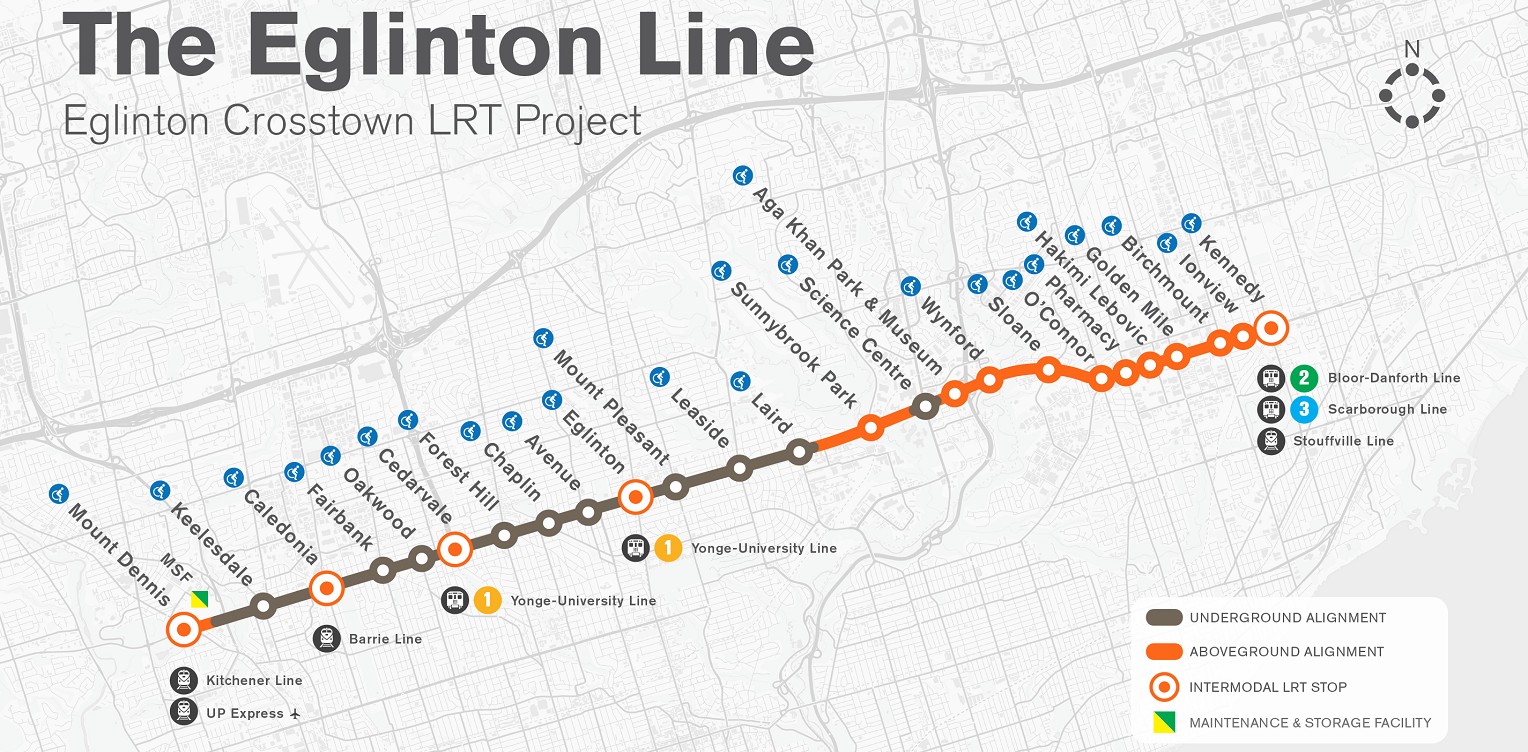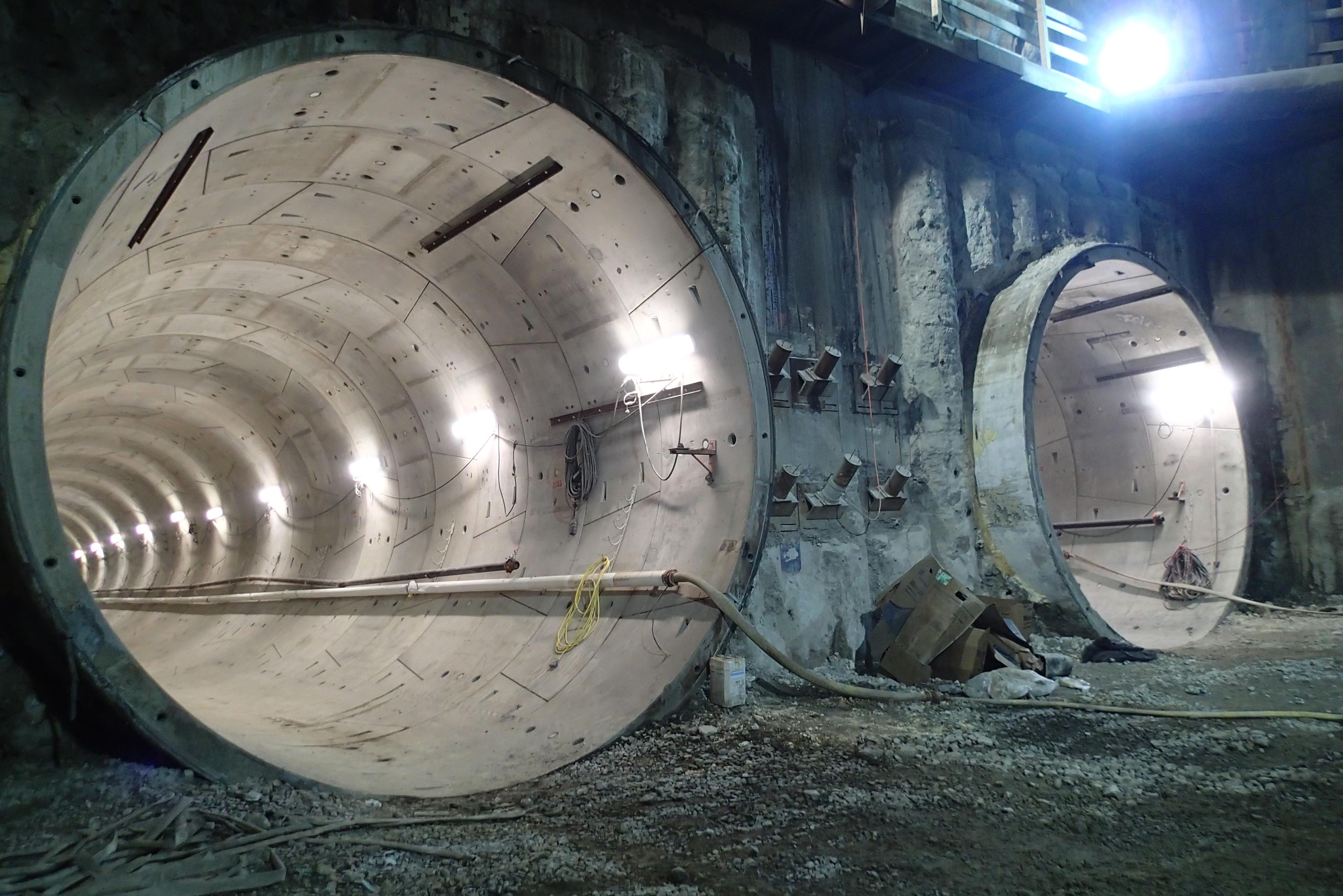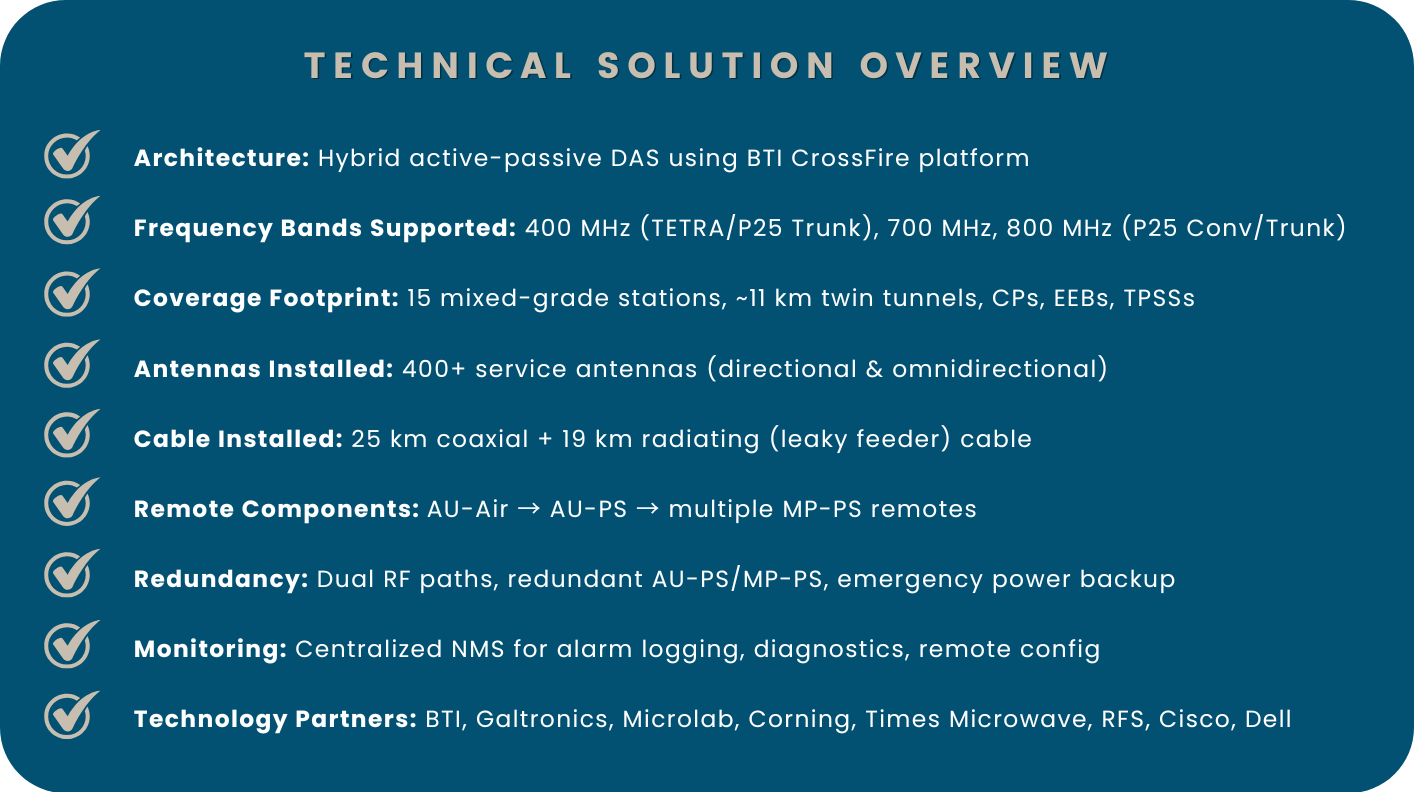Eglinton Crosstown LRT (ECLRT) - Operational Radio Distributed Antenna System (DAS)
A Case Study
AT A GLANCE
Customer: Crosslinx Transit Solutions
Location: Toronto, Ontario
Market: Transportation
Infrastructure:
- 11 km of underground twin tunnels
- 15 mixed-grade stations
Project Duration: 2018 - 2025
Technology Focus:
- BTI CrossFire fibre-fed digital active operational radio DAS
Challenge:
- Deliver seamless multi-agency radio coverage across 11 km of tunnels and 15 stations, meeting diverse integration and coverage needs for TTV, Tri-Services, and government agencies.
Solution:
Turnkey design and deployment of in-tunnel and in-building DAS supporting UHF, 700, and 800 MHz–designed for integration and scalable, uninterrupted communications across transit and emergency networks.
CUSTOMER
The Eglinton Crosstown Light Rail Transit (ECLRT) is one of Canada’s largest transit expansions—a $6.6 billion investment spanning 19 kilometres across Toronto with 25 stations and stops, including a combination of underground and surface-level facilities known as mixed-grade stations. Running east–west along Eglinton Avenue, the line is expected to improve midtown travel times by up to 60%. Delivered through a public-private partnership by Crosslinx Transit Solutions (CTS) on behalf of Metrolinx and Infrastructure Ontario, the project involves over 2,400 workers and complex multi-agency coordination.
With 11 kilometres of twin-tunnels running deep underground, ensuring uninterrupted wireless communication for operations and emergency response posed major challenges. CTS engaged Cartel Communication Systems to design, engineer, and deploy a highly resilient Distributed Antenna System (DAS) to deliver seamless, mission-critical radio coverage across tunnels, above-ground and below-ground stations, and support infrastructure. Cartel’s solution supports multiple radio systems and public safety agencies, integrating directly with the Toronto Transit Commission (TTC) for transit operations, Tri-Services (police, fire, and EMS) for emergency response, and other governmental agencies responsible for public safety communications—ensuring reliable coverage where it’s needed most.

CHALLENGE
The ECLRT includes approximately 11 km of underground twin-tunnels, 15 mixed-grade stations, and dozens of confined spaces such as Cross Passages (CPs), Emergency Exit Buildings (EEBs), and Traction Power Substations (TPSSs). In such complex environments, radio communications networks fail to permeate the indoor and underground environments, making uninterrupted wireless communication for operations, safety, and emergency response a significant challenge.
The DAS had to ensure seamless, high-reliability radio coverage across all underground spaces—not only for TTC operational staff, but also for multiple emergency and governmental service agencies. These users operate across different technologies and frequency bands, including 400, 700, and 800 MHz systems. The design had to support each group’s stringent performance requirements while maintaining interoperability.
Further complicating matters, the system needed to integrate with existing infrastructure and legacy networks at various Points of Interface (POIs) across the city. This required clean signal ingress/egress at tunnel portals and interchange stations, with smooth hand-off to above-ground networks.
Finally, the solution needed to be resilient: engineered with redundancy and fail-safes to eliminate single points of failure.
All of this had to be coordinated with multiple stakeholders under tight construction schedules and strict compliance standards. CTS needed a system that could blanket the underground alignment with robust, scalable, and interference-free public safety communications.

SOLUTION
Cartel delivered a fully integrated, in-tunnel and in-building DAS solution built for high reliability, interoperability, and future scalability. Working closely with CTS, Cartel led the complete system deployment—from design and engineering through installation, commissioning, and lifecycle management.
At the core of the system’s hybrid active-passive architecture—leveraging both fibre and coaxial distribution—is the BTI CrossFire Platform, supporting multi-band, multi-agency coverage across 400, 700, and 800 MHz. The system includes dual head-end units and dozens of remote access points to ensure comprehensive coverage across 15 mixed-grade LRT stations, twin tunnels, Cross Passages (CPs), Emergency Exit Buildings (EEBs), and Traction Power Substations (TPSSs). Radiating coaxial cables (“leaky feeders”) run through the tunnels, while distributed service antennas provide focused coverage within stations and back-of-house areas.
To achieve consistent coverage, Cartel deployed approximately 25 km of coaxial cable, 19 km of radiating cable, and over 400 service antennas throughout the ECLRT alignment. This ensures reliable signal availability across both public-facing and technical spaces, including stairwells, shafts, and utility rooms. The DAS extends or enhances coverage for TTC’s TETRA system and multiple public safety and government radio systems. Interface points are located at TTC Hillcrest and McBrien, the primary communications centre at the Eglinton Maintenance and Storage Facility (EMSF), Kennedy Station’s backup control center, 40 College, and the North American Centre—ensuring seamless signal ingress/egress and handoff to surface networks.
The architecture features AU-AIR modules at the signal intake, followed by AU-PS distribution units, which feed multiple MP-PS remotes positioned throughout the network. Redundancy is built into both the AU-PS and MP-PS layers, ensuring high availability across the DAS. While the AU-AIR units are non-redundant, the overall system is designed for fault tolerance. Centralized monitoring and remote configuration are managed through a Network Management System (NMS).

The DAS supports multiple frequency bands and user groups — ensuring full interoperability for TTC, Toronto Police, Fire, EMS, and other agencies — including: 400 MHz (TETRA and P25 trunked systems), 800 MHz (P25 conventional and trunked systems), and 700 MHz (reserved for future public safety expansion). Engineered for high availability, the system includes dual RF paths, redundant fibre routes, backup power, and ruggedized components suitable for transit environments. The DAS meets or exceeds public safety standards for RF strength and audio clarity, verified through rigorous testing with TETRA radios, PCTel scanners, and agency-specific handhelds.
The DAS solution used high-quality components from leading technology partners, including:
- BTI Wireless – Active DAS platform (CrossFire), including head-end and remote radio units
- RFS – Radiating (leaky feeder) and coaxial cable infrastructure
- Microlab – RF combiners, couplers, and splitters for signal distribution
- Galtronics – In-building and tunnel antennas (omni and directional)
- Corning – Fiber connectivity components and enclosures
- Times Microwave – Coaxial jumpers and RF cable assemblies
- Centric RF – RF adapters and connectors
- Cisco & Dell – Network switching, routing, and hardware for system monitoring and management (NMS)
RESULTS & BENEFITS
Cartel’s DAS solution has delivered seamless, interoperable communications across the entire underground alignment of the ECLRT. Transit operators, TTC staff, first responders—including police, fire, and EMS, and various governmental agencies can now maintain uninterrupted radio contact throughout tunnels, stations, and confined spaces. This has significantly enhanced situational awareness, response coordination, and public safety.
Verified through rigorous testing, the DAS meets strict performance standards for signal strength and audio clarity—achieving 95% or greater coverage in general areas and 97% in firefighter access zones, with no single coverage gap exceeding 2 meters (or 1 meter in FFAs). This ensures reliable two-way communication throughout even the most challenging underground environments for both operational and emergency use. The system integrates smoothly with the TTC’s, Tri-Services’, and other government agencies’ emergency networks, providing transparent roaming and handoff. Built on the modular BTI CrossFire platform, the DAS is fully scalable to support future technologies and network expansions, including additional radio bands or 5G/IOT services.
Cartel’s Life Cycle Management ensures long-term system performance and support, offering CTS and transit authorities a single, trusted point of contact for maintenance and upgrades. The ECLRT DAS is a model for safe, scalable transit communication; is future-ready and is designed to meet the operational demands of a world-class transportation system.

CONCLUSION
Cartel’s DAS solution has equipped the ECLRT with a resilient, future-ready communications backbone—engineered for seamless interoperability across public safety and transit operations. This project demonstrates our ability to meet the stringent technical, regulatory, and operational demands of modern rail infrastructure. With over 30 years of experience, Cartel specializes in turnkey DAS solutions for complex environments—including underground tunnels, mixed-grade stations, and multi-agency communication systems. Our expertise spans multi-band support, redundant architecture, and performance validation. Whether you’re planning a new transit build or upgrading existing infrastructure, we bring the proven technical leadership and track record needed to deliver.
